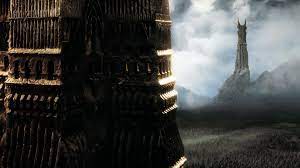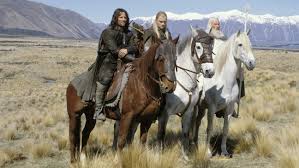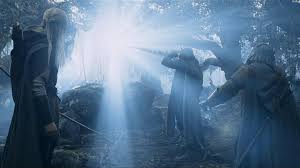🎬 The Lord of the Rings: The Two Towers (2002)

🎬 The Lord of the Rings: The Two Towers (2002) – A Breathtaking Journey of Courage and Unity
Introduction
The Lord of the Rings: The Two Towers (2002), directed by Peter Jackson, is the second installment in the epic film adaptation of J.R.R. Tolkien’s legendary trilogy. Picking up where The Fellowship of the Ring left off, the film expands the narrative’s scope, diving deeper into Middle-earth’s sprawling landscapes, the characters’ evolving arcs, and the growing shadow of Sauron. With breathtaking battles, emotional depth, and groundbreaking visual effects, The Two Towers stands as a monumental achievement in cinematic history.
Plot Summary
The fellowship has fractured, but the mission to destroy the One Ring endures. Frodo (Elijah Wood) and Sam (Sean Astin) venture toward Mordor, encountering the enigmatic and tormented creature Gollum (Andy Serkis), who becomes their reluctant guide. Gollum’s dual nature poses a constant threat to their trust and survival.
Meanwhile, Aragorn (Viggo Mortensen), Legolas (Orlando Bloom), and Gimli (John Rhys-Davies) pursue the orcs who have captured Merry (Dominic Monaghan) and Pippin (Billy Boyd). Their journey leads them to the war-torn kingdom of Rohan, where King Théoden (Bernard Hill) has fallen under the spell of Saruman’s agent, Gríma Wormtongue (Brad Dourif). With the help of Gandalf the White (Ian McKellen), Théoden regains his strength to lead his people against the forces of Isengard.
The climactic Battle of Helm’s Deep is a masterclass in tension and spectacle, as the free peoples of Rohan make their stand against Saruman’s monstrous Uruk-hai army. Amidst these grand conflicts, the entwined themes of friendship, hope, and resilience shine, keeping the flame of the fellowship alive.
Themes and Analysis
- The Burden of Leadership
Aragorn, Théoden, and Frodo all face the weight of leadership, each grappling with the responsibilities and sacrifices required to protect those they care about. - Hope Against Darkness
The film underscores the importance of hope in the face of overwhelming odds. Gandalf’s words, “There is always hope,” resonate as a central theme, inspiring characters to persevere. - Duality of Good and Evil
Gollum embodies the conflict between light and dark within all beings, offering a poignant reflection of the Ring’s corrupting power and the possibility of redemption. - Unity in Diversity
The alliance between men, elves, dwarves, and hobbits highlights the strength found in overcoming differences to face a common enemy.
Characters and Performances
- Elijah Wood as Frodo Baggins
Wood portrays Frodo’s growing weariness and inner struggle with profound vulnerability, capturing the toll of carrying the Ring. - Sean Astin as Samwise Gamgee
Astin’s heartfelt performance solidifies Sam as the emotional core of the story, demonstrating unwavering loyalty and bravery. - Andy Serkis as Gollum
Serkis delivers a groundbreaking performance, blending physicality and vocal nuance to bring Gollum to life through cutting-edge motion-capture technology. - Viggo Mortensen as Aragorn
Mortensen’s portrayal of Aragorn’s reluctant rise to leadership is both commanding and heartfelt, reflecting his inner conflict and unwavering courage. - Bernard Hill as King Théoden
Hill brings depth to Théoden’s arc, capturing his transformation from a broken, manipulated king to a determined leader.
Visuals and Special Effects
The film’s visuals are nothing short of revolutionary. Weta Workshop’s meticulous craftsmanship and Weta Digital’s pioneering CGI bring Middle-earth’s landscapes, battles, and creatures to life. The introduction of Gollum remains a landmark achievement in visual effects, seamlessly blending technology with performance.
The Battle of Helm’s Deep is an unparalleled cinematic feat, showcasing Peter Jackson’s mastery of scale, strategy, and emotion. The rain-drenched, night-lit siege is both visually stunning and emotionally gripping, setting a new benchmark for epic battle sequences.
Soundtrack and Atmosphere
Howard Shore’s Oscar-winning score amplifies the film’s grandeur and emotional resonance. Iconic themes like “The Riders of Rohan” and “Evenstar” evoke both the sweeping beauty and the sorrow of Middle-earth, immersing viewers in its rich world.
Critical Reception
The Two Towers received widespread acclaim for its storytelling, character development, and technical achievements. Critics praised its ability to balance multiple narratives while delivering unforgettable moments of drama and action. It won two Academy Awards, including Best Visual Effects, and remains a fan favorite.
Why The Two Towers is a Must-Watch
The film masterfully bridges the intimate struggles of its characters with the grandeur of Middle-earth’s epic conflicts. Its themes of hope, resilience, and unity resonate universally, making it more than just a fantasy film—it’s a story of humanity.
Conclusion
The Lord of the Rings: The Two Towers is a towering achievement in filmmaking, blending stunning visuals, complex characters, and timeless themes. As the middle chapter of a legendary trilogy, it elevates the stakes while delivering an unforgettable cinematic experience.